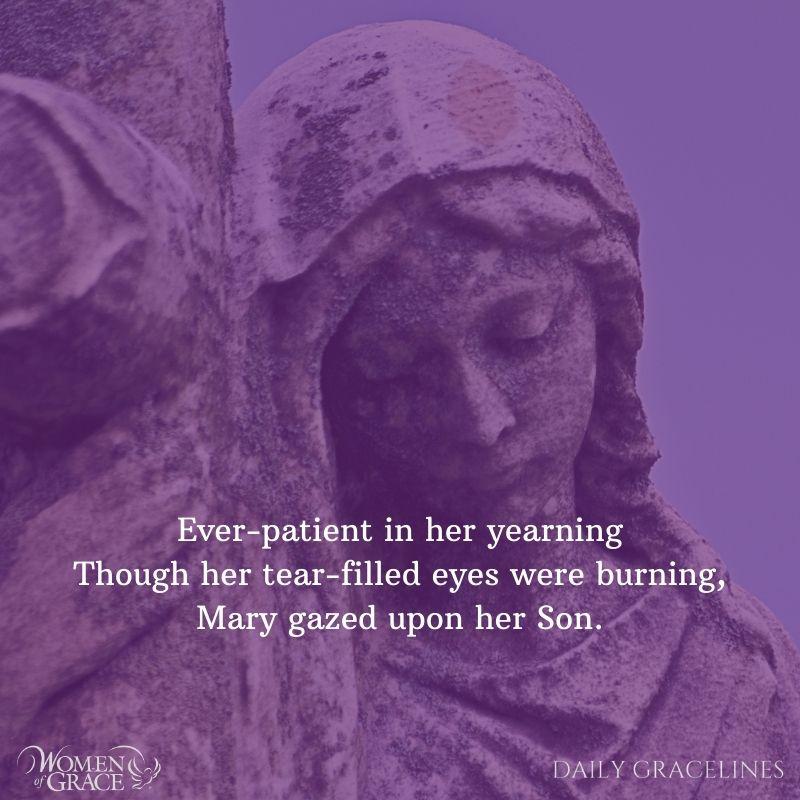
March 16
Ever-patient in her yearning
Though her tear-filled eyes were burning,
Mary gazed upon her Son.
For Reflection:
In his writing, The Spirituality of Waiting, Henri Nouwen gives five characteristics of waiting. He tells us waiting is a movement. “People who wait have received a promise that allows them to wait. … They have received something that is a work in them, like a seed that has started to grow… So waiting is never a movement from nothing to something. It is always a movement from something to something more.”
How is this truth depicted in the stanza above? Consider Mary’s gaze. What might have been transpiring in her heart as Mary looked upon her Son and as He gazed upon her? What promise(s) had she received and what might be the “something more” still yet to come?
If you enjoy Daily Gracelines, please prayerfully consider making a donation to support and sustain our apostolate so that we may continue to provide this and all of our resources designed to nourish and grow your Catholic faith.
DONATE
Read the rest
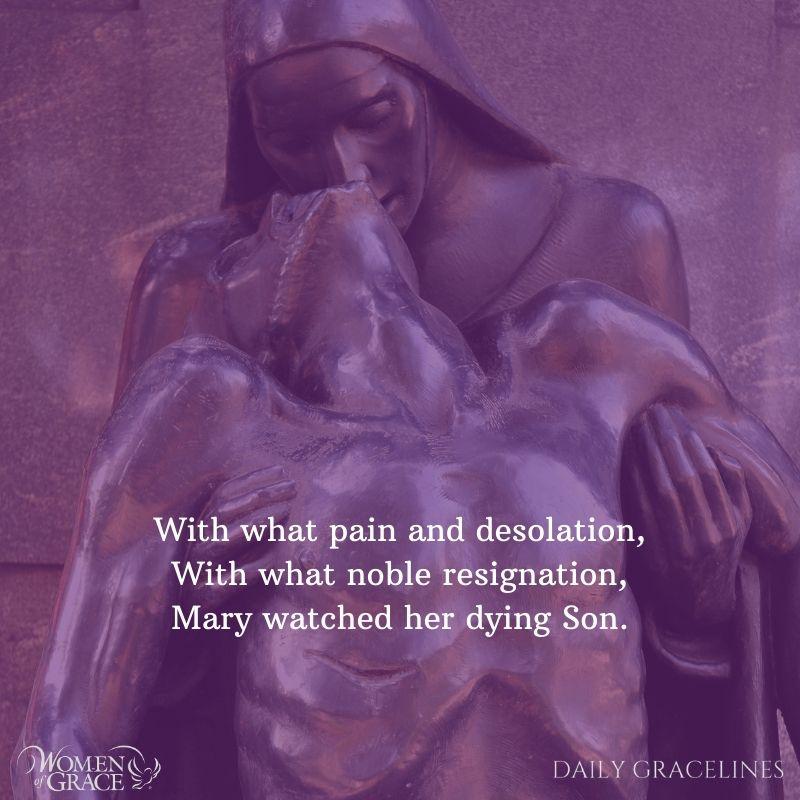
March 15
With what pain and desolation,
With what noble resignation,
Mary watched her dying Son.
For Reflection:
Many spiritual writers have discussed the “spirituality of waiting” and the
virtues it requires. Some of these are patience, long-suffering, trust,
surrender, humility, gratitude, receptivity, hope. In what ways do you think Mary embodied all of these as she watched her Son die? Which of these
do you most need to acquire?
If you enjoy Daily Gracelines, please prayerfully consider making a donation to support and sustain our apostolate so that we may continue to provide this and all of our resources designed to nourish and grow your Catholic faith.
DONATE
Read the rest
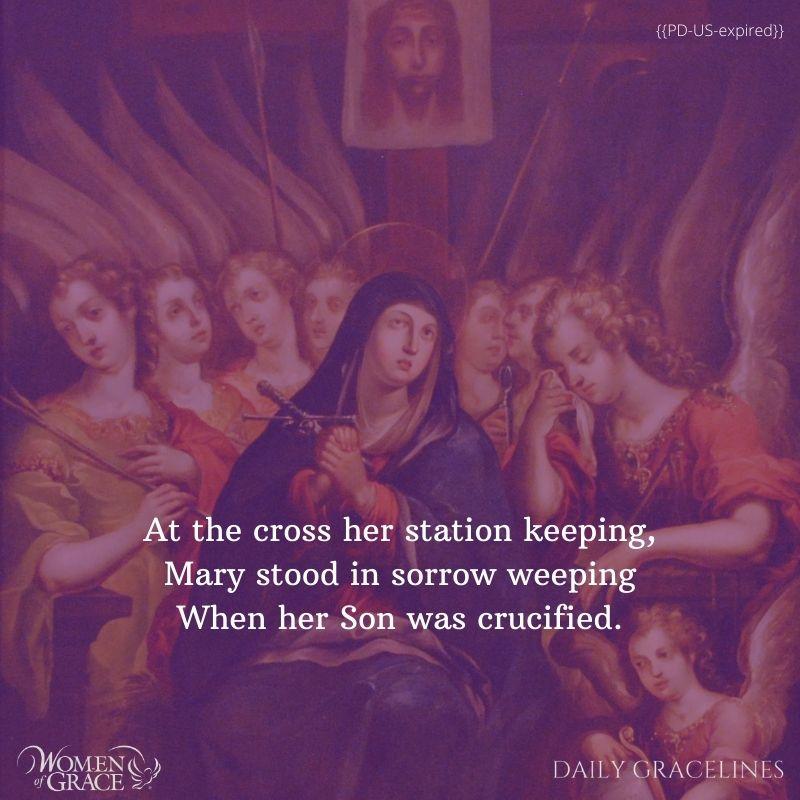
March 14
While she waited in her anguish,
Seeing Christ in torment languish,
Bitter sorrow pierced her heart.
For Reflection:
This verse tells us Mary “waited.” What attitude of heart do you think marked Mary’s disposition as she waited? What virtues? Recall a time when you, too, waited. What marked your disposition? What virtues did you exhibit?
If you enjoy Daily Gracelines, please prayerfully consider making a donation to support and sustain our apostolate so that we may continue to provide this and all of our resources designed to nourish and grow your Catholic faith.
DONATE
Read the rest
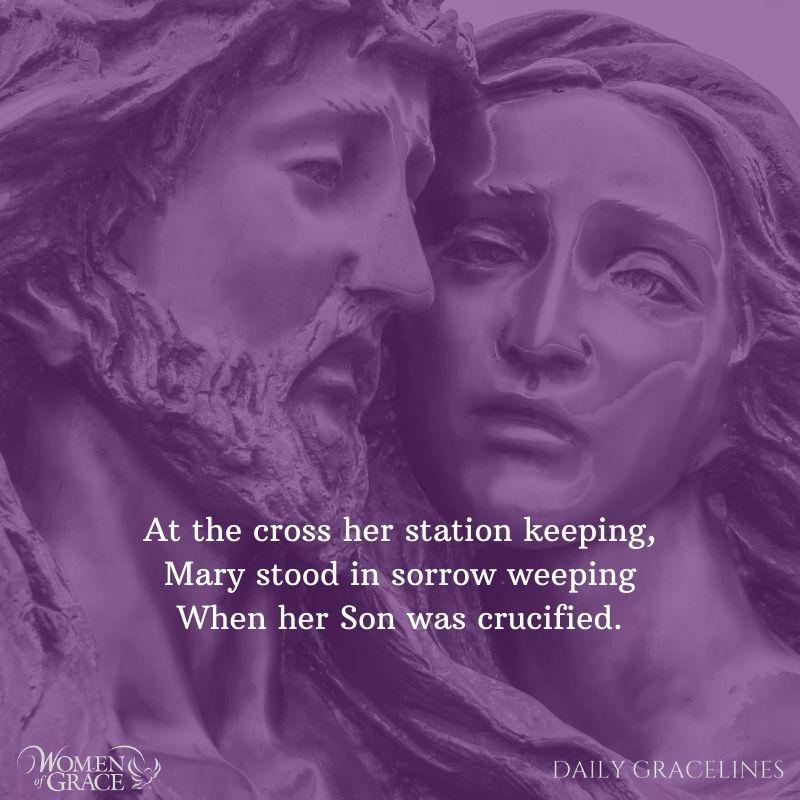
March 13
At the cross her station keeping,
Mary stood in sorrow weeping
When her Son was crucified.
For Reflection:
Father Faber tells us that each consecutive suffering of Our Lady outstripped its predecessor in pain, because each new suffering had “more love to torture, and therefore more power of inflicting pain.” In this first verse of the Stabat Mater, Mary experiences the fifth sword to her heart. She is at the summit of her suffering. Consider Father Faber’s quote in light of this. What do you think he means by “more love to torture?” What is the connection between love and pain? To what extent are you willing to truly love?
If you enjoy Daily Gracelines, please prayerfully consider making a donation to support and sustain our apostolate so that we may continue to provide this and all of our resources designed to nourish and grow your Catholic faith.
DONATE
Read the rest
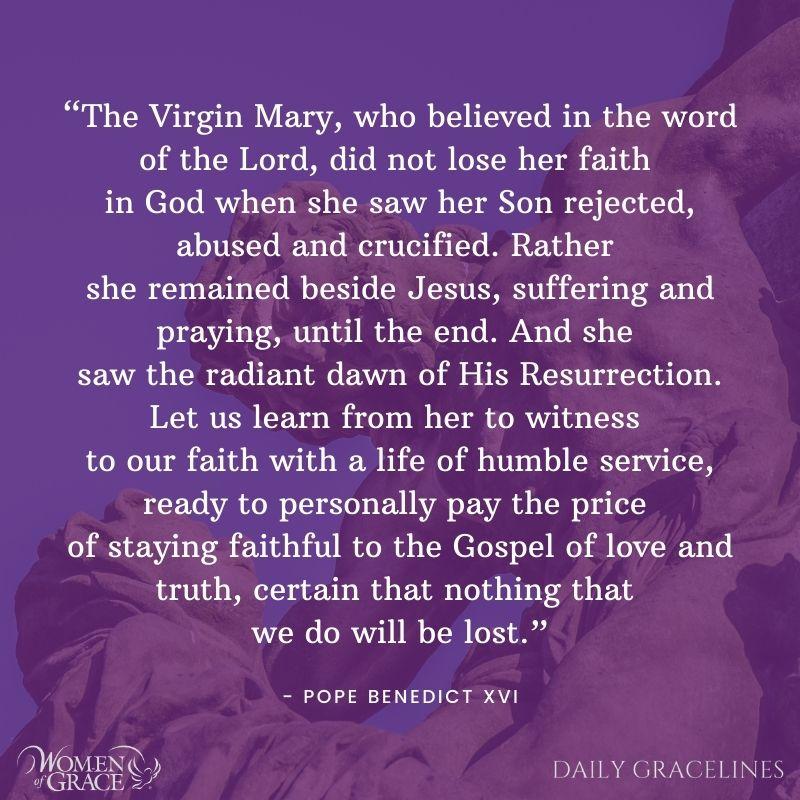
March 12
“The Virgin Mary, who believed in the word of the Lord, did not lose her faith
in God when she saw her Son rejected, abused and crucified. Rather
she remained beside Jesus, suffering and praying, until the end. And she
saw the radiant dawn of His Resurrection. Let us learn from her to witness
to our faith with a life of humble service, ready to personally pay the price
of staying faithful to the Gospel of love and truth, certain that nothing that
we do will be lost.”
- Pope Benedict XVI
For Reflection:
In what way do these words of the Holy Father speak to you today? Are we willing to face the moments of our life, from this second forward in persona Maria? How have Mary’s dolors encouraged you and strengthened you to do so?
If you enjoy Daily Gracelines, please prayerfully consider making a donation to support and sustain our apostolate so that we may continue to provide this and all of our resources designed to nourish and grow your Catholic faith.
DONATE
Read the rest

March 11
“The everlasting God has in His Wisdom foreseen from eternity, the cross He now presents to you as a gift from his innermost heart. This cross He now sends You He has considered with His all-knowing eyes, understood with His divine mind, tested with his wise justice, warmed with His own hands to see that it not be one ounce too heavy for you. He has blessed it with His holy Name, anointed it with His grace, perfumed it with his consolation, and taken one last glance at you and your courage – has sent it to you from heaven, a special greeting from God to you, an alms of the all merciful love of God.”
- St. Francis de Sales
For Reflection:
How do you think Mary would have responded to these words of St. Francis de Sales? How do you respond? Reflect on this quote in light of Mary and her seven dolors. Reflect on it in light of the sufferings you have borne and ones you may be bearing now. Record your insights, thoughts, inspirations, or reflections.
If you enjoy Daily Gracelines, please prayerfully consider making a donation to support and sustain our apostolate so that we may continue to provide this and all of our resources designed to nourish and grow your Catholic faith.
DONATE
Read the rest
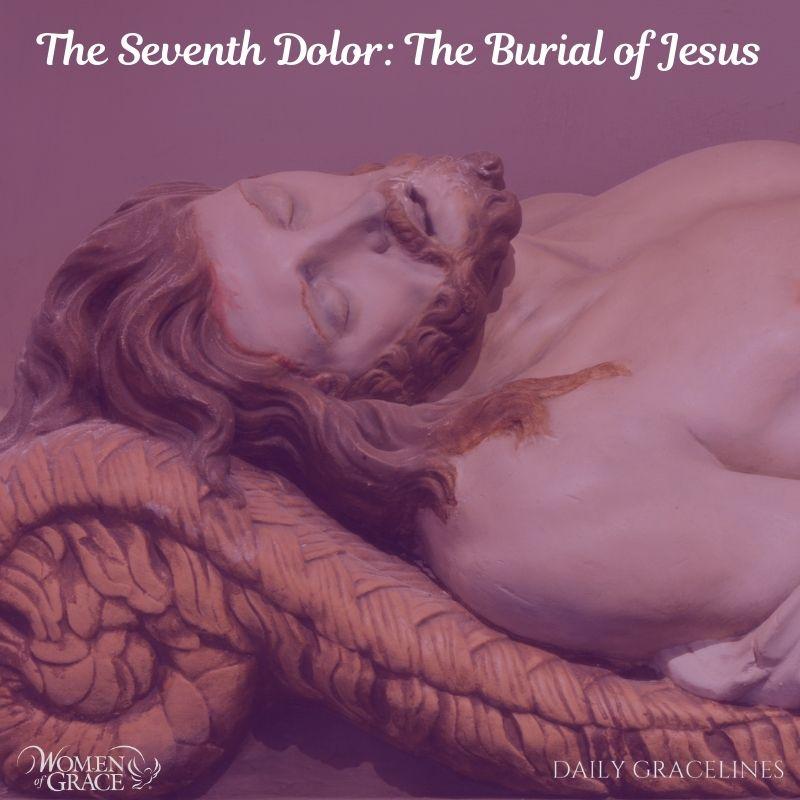
March 10
The Seventh Dolor: The Burial of Jesus
From the beginning of the victim’s torture until after his death, crucifixion was a nasty and brutal affair. It was rare that the criminal was buried after he died. Most typically, the body was left to be devoured by beasts and birds of prey. One exception, however, applied to Jews. Because their religious law required a person accused of a capital offense to be buried on the same day as his death (see Deut. 21: 22-23), the Romans permitted the body to be removed for burial – usually for a price. Since death from crucifixion could take up to three days, this usually required a hastening of the dying process. Soldiers would often kindle a fire under the crucified, or let hungry beasts attack them, or break their bones with an iron mallet to induce suffocation. Fortunately for Our Lord, none of this was necessary thereby fulfilling Scripture (Exodus 12:46).
For Reflection:
Read the account of Jesus’ burial in Mark 15: 42-47. What parallels do you see between it and today’s GraceLine? Though the Blessed Mother is not specifically mentioned, it was customary for the family members of the deceased to prepare the body for burial and then proceed to the burial site in a procession of lamentation and mourning. Picture Our Lady performing these last acts of love for her Son. What does Mary do? What words come to mind to describe the quality of her actions? What thoughts do you think played at her memory? What emotions did she experience? Journal your reflections.
If you enjoy Daily Gracelines, please prayerfully consider making a donation to support and sustain our apostolate so that we may continue to provide this and all of our resources designed to nourish and grow your Catholic faith.
DONATE
Read the rest

March 9
“No one can suggest that God did not love the Blessed Virgin. Nevertheless, He did not exempt her for Calvary, or from making her participate in the Cross to a fuller extent than anyone else in the world except her Son. It would be foolish – to think that if God really loves us, as He does, He will exempt us from the Cross, the sign of the Christian.”
-Federico Suarez
For Reflection:
Christian thinking has always posited the Cross as the consummate sign of victory. We even celebrate a feast day in celebration of it – September 14, The Triumph of the Cross. How was Calvary and the Cross, Jesus's greatest triumph? Mary’s? How does the Cross, then, speak of God’s love for us -- first, in reception of the fruits it has gained for us; and second, in the entrustment of the cross we carry? To what extent does this insight lighten the burden?
If you enjoy Daily Gracelines, please prayerfully consider making a donation to support and sustain our apostolate so that we may continue to provide this and all of our resources designed to nourish and grow your Catholic faith.
DONATE
Read the rest

March 8
To Mary: At the Thirteenth Station
You are the priest tonight:
The paten of your lap holds sacrifice.
You are the priest tonight,
Offering Peace and its price.
Star candles burn palely bright;
John is your faithful acolyte.
You are the priest tonight.
-Raymond Roseliep
M. Thérèse. I Sing of a Maiden: The Mary Book of Verse.
New York: Macmillan, 1947.
For Reflection:
How is this scene almost para- liturgical? Read Paragraphs, 783 and 1546 in the Catechism of the Catholic Church in light of the poem. Do you think the description of Mary as priest is an apt one? What deeper insights does this give you into the mystery of Mary, her union with her Son and His sacrifice, and the suffering they shared in common?
If you enjoy Daily Gracelines, please prayerfully consider making a donation to support and sustain our apostolate so that we may continue to provide this and all of our resources designed to nourish and grow your Catholic faith.
DONATE
Read the rest
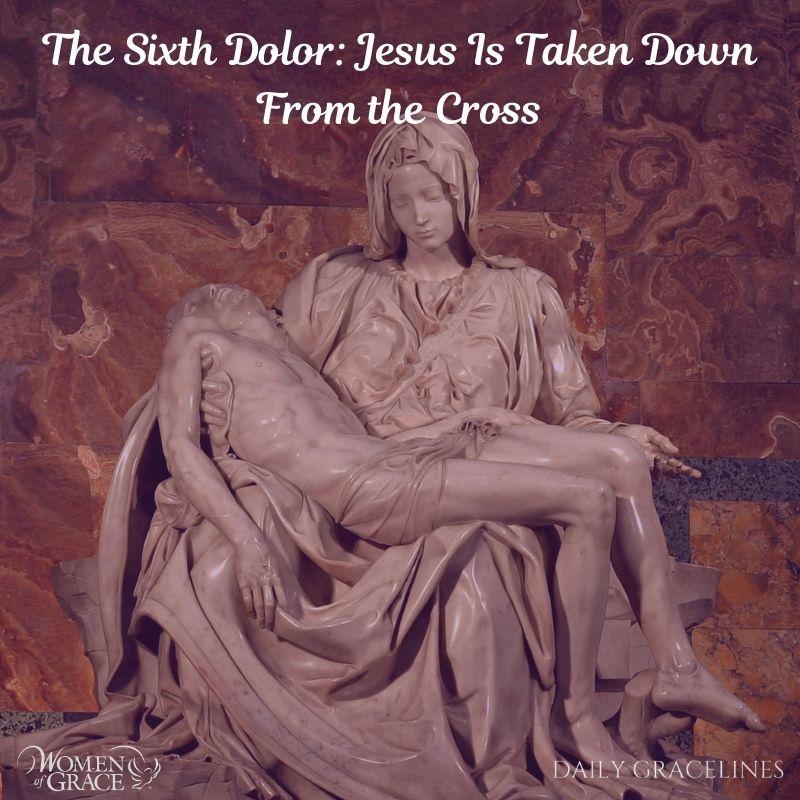
March 7
The Sixth Dolor: Jesus Is Taken Down From the Cross
Tradition has it that Jesus’ body was placed in His mother’s arms after he was taken down from the Cross. This touching scene became the subject of artistic renderings around 1300, with the most famous of all being Michelangelo’s sculpture in white marble. The Pieta has been housed in St. Peter’s Basilica since the early 18th Century.
For Reflection:
Michaelangelo’s sculpture captures in marble – a deepening insight into the mystery of Mary, Virgin and Mother, whose Son was her Savior and her God, and Whose suffering was mystically her own.
If you enjoy Daily Gracelines, please prayerfully consider making a donation to support and sustain our apostolate so that we may continue to provide this and all of our resources designed to nourish and grow your Catholic faith.
DONATE
Read the rest










